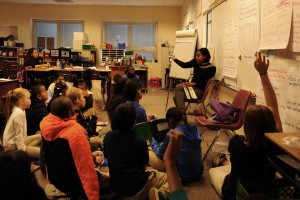Inclusion at Maxwell: 100% of Adults for 100% of Students
Philosophy of Inclusion
At Maxwell, we believe that all of our students have talent and potential. We are committed to ensuring that all students, including all students of color, English learners, students with disabilities, and LGBTQ students, feel valued and known by teachers, leaders, and classmates, and learn in the general education classroom setting.
Inclusion is a way of thinking and acting that allows every individual to feel accepted, valued, and safe. An inclusive community evolves to meet the needs of its members. At Maxwell we embrace inclusion as a means of enhancing the well-being of every member of our school community.
Inclusion at a Glance
 In an inclusion classroom, general education teachers and special education teachers work together to meet the needs of all students.
In an inclusion classroom, general education teachers and special education teachers work together to meet the needs of all students.Inclusion Benefits All!
All students learn differently. This is a principal of inclusive education. In co-taught classrooms students receive instruction in ways that they learn best, targeted to their individual needs. Students are often taught in small groups, or provided with 1 on 1 feedback to ensure students learn new content. By using small groups, teaching can be tailored to the all students’ needs, and that students are provided with challenging content as well!
Supported Teaching Strategies
In an inclusive classroom, teachers weave in specially designed instruction and support that can help students make progress. Kids may be given opportunities to move around or use tools that help them focus. These strategies are helpful for all students—not only for students with learning and attention issues.
Reduced Stigma
Inclusive classrooms are filled with diverse learners. That lets kids talk about how everyone learns in their own way. They may find that they have more in common with other kids than they thought. This can go a long way in reducing stigma for kids with learning and attention issues.
Effective Use of Resources
In more traditional special education settings, many kids are “pulled out” for related services, like speech therapy or for other specialized instruction. An inclusion class often brings speech therapists, social workers and other service providers into the classroom. These professionals can provide information and suggestions to help all students. If your child isn’t eligible for special education, but still needs some extra support, they will receive it in the co-taught class.
High Expectations of All
If your child has an Individualized Education Program (IEP), their goals should be based on the academic standards for your state. Those standards lay out what all students are expected to learn in math, reading, science and other subjects by the end of the school year. Differentiated instruction and co-teaching in a general education classroom make it easier for students with standards-based IEPs to be taught the same material as their classmates.